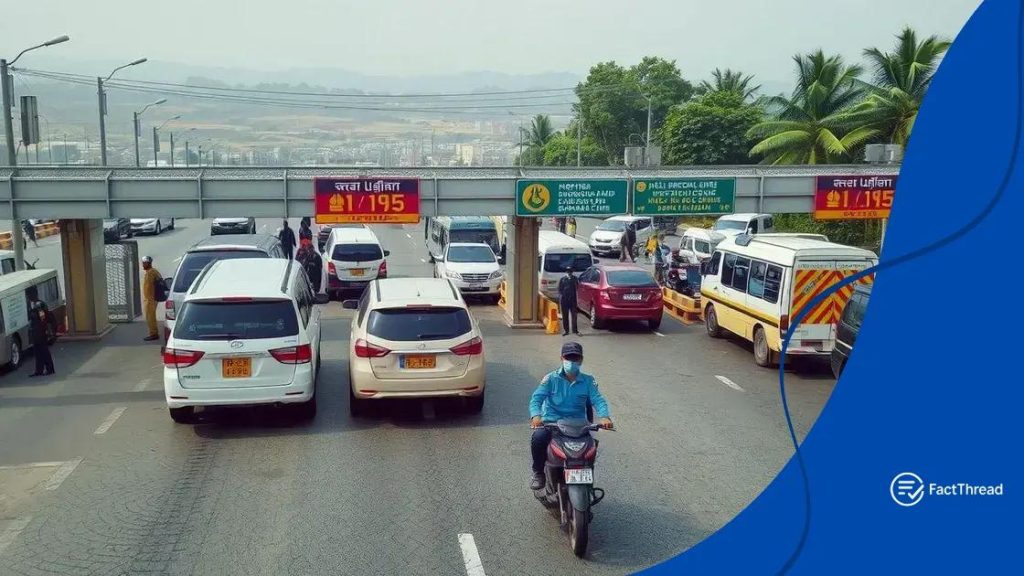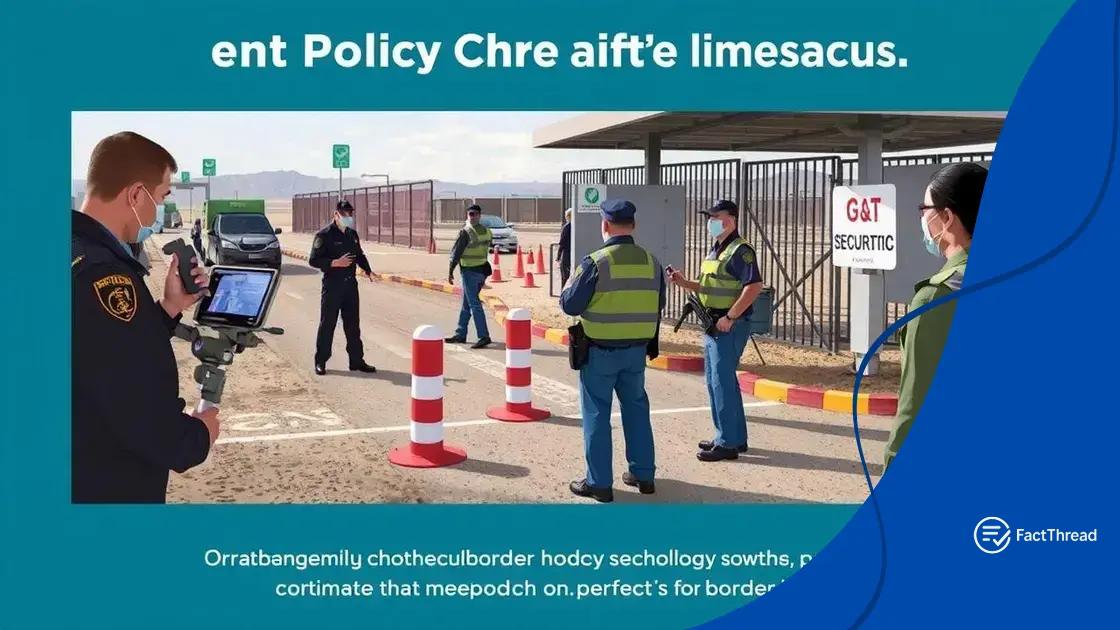Administration addresses concerns about border security

Administration addresses concerns about border security by implementing new policies focused on enhanced safety measures, technological advancements, and community engagement to balance enforcement with humanitarian needs.
Administration addresses concerns about border security is a topic that impacts many citizens daily. Have you considered how these policies might affect your community? In this article, we’ll delve into the latest developments and their implications.
The current state of border security
The current state of border security plays a crucial role in shaping our nation’s safety and international relations. A complex web of policies and practices governs how borders are secured today, aiming to keep citizens safe while balancing the need for trade and tourism.
Many factors influence the present climate of border security. Technological advancements have enhanced monitoring capabilities. For example, the use of drones and surveillance cameras allows for real-time assessments of border activities. These tools help authorities respond quickly to potential threats and streamline the management of border checkpoints.
Key Features of Current Border Security
One major aspect of today’s border security is the combination of physical barriers and technological resources. This approach aims to deter illegal crossings while facilitating legitimate travel.
- Enhanced surveillance systems provide accurate data on border activities.
- Trained personnel are stationed at crucial points to monitor and manage movement.
- Legal frameworks are updated to address emerging security challenges.
Moreover, the involvement of local communities is vital. Individuals living near border areas often collaborate with security forces to bolster safety. Their insights are crucial in identifying suspicious activities and reporting them promptly.
International cooperation is also essential for effective border security. Countries often work together to share intelligence and strategies, making it harder for illegal activities to thrive. Global partnerships can lead to advancements in technology and the development of best practices.
Public sentiment surrounding border security varies widely, influenced by personal experiences and political views. Some advocate for stricter measures, while others emphasize the importance of humane treatment of migrants. Balancing these perspectives is key to forming a comprehensive security policy.
Key challenges facing border security
Border security faces numerous challenges that can complicate the safety and control of national boundaries. Factors such as resource limitations and evolving threats make it essential to stay vigilant and adaptable.
One of the most significant challenges is the increase in illegal crossings. As technology and tactics improve, individuals seeking to bypass border controls become more creative. This constant change requires authorities to be proactive in their strategies.
Resource Limitations
Many border security agencies operate under tight budgets. Providing adequate personnel, equipment, and training often presents a tough balancing act. Limited funding can hinder effective surveillance and response capabilities, making it difficult to maintain safety.
- Insufficient personnel can lead to gaps in coverage, especially during peak times.
- Outdated technology limits the ability to monitor and respond effectively.
- Training programs may not keep pace with changes in tactics used by those attempting to cross borders illegally.
Another challenge is the need for inter-agency collaboration. Various departments and agencies handle different aspects of border security. Coordination among these entities is essential to ensure a united front against threats. When communication and teamwork falter, the effectiveness of border security can decline.
Public perception of border security also plays a vital role in shaping policies and responses. Misinformation and differing opinions can create tension within communities. Governments must work hard to build trust and understanding with the public regarding security measures.
Lastly, the impact of global events cannot be ignored. Changes in international relations, economic conditions, and humanitarian crises can all lead to shifts in migration patterns. Understanding these factors is crucial for adapting strategies and ensuring that resources are appropriately allocated to manage emerging challenges.
Recent policy changes by the administration

Recent changes in policies regarding border security have sparked discussions and varying opinions among citizens and officials alike. These adjustments reflect a response to changing conditions and emerging challenges in managing borders.Policy changes often aim to enhance security while addressing humanitarian concerns.
These updates may include new protocols for customs and immigration procedures. One significant change involves streamlining the process for legitimate travelers to cross borders more efficiently. This shift aims to reduce wait times and improve the flow of people and goods.
Enhanced Security Measures
Another recent policy shift emphasizes enhanced security measures. This includes expanding surveillance technologies and increasing the presence of security personnel at key border points. The administration acknowledges that a visible presence can deter unlawful crossings and make travelers feel safer.
- The use of biometric technology allows for quicker identification of individuals.
- Increased funding supports training programs for border personnel.
- Partnerships with local law enforcement aim to improve community engagement.
In addition to physical security enhancements, there are also policy changes related to handling asylum seekers and undocumented immigrants. The administration is working on creating more humane processes for individuals seeking refuge. This effort includes reviewing the asylum application processes and ensuring appropriate support services are available.
Balancing enforcement and compassion remains a key goal for the administration. Public opinion and advocacy groups play a vital role in shaping how these policies develop. Feedback from communities along the borders helps inform these crucial decisions.
Finally, it is essential to monitor the impact of these policy changes over time. Continuous assessment allows for adjustments to be made as new challenges arise. This commitment to adapting strategies reflects an understanding of the dynamic nature of border security.
Community responses and concerns
Community responses to border security issues reflect a wide range of concerns and ideas. Many individuals living near borders feel directly impacted by the policies and practices that govern their daily lives.
Local communities often express a mix of support and opposition to current border security measures. Some residents advocate for stronger enforcement to protect their neighborhoods from crime, while others urge a more compassionate approach toward migrants. This divide can lead to lively discussions on what is best for community safety and well-being.
Concerns About Safety
Safety is a top priority for many living near borders. Residents frequently cite increased crime rates as a significant concern linked to illegal crossings. They want assurance that local law enforcement has the tools and resources needed to keep their neighborhoods secure.
- Some community members call for increased police presence to deter crime.
- Others advocate for better training in cultural sensitivity for officers.
- Community watch programs have formed to enhance local vigilance.
However, community responses can also highlight the fears surrounding enforcement tactics. Many are worried about the potential for racial profiling and the impact it may have on relationships within multicultural neighborhoods. These concerns underscore the need for local law enforcement to engage in transparent dialogue with residents.
Moreover, humanitarian concerns are prevalent among various community groups. Many advocate for the rights of migrants and asylum seekers, emphasizing the importance of understanding their struggles. They believe that everyone deserves fair treatment and access to resources, regardless of their immigration status.
As communities respond to the realities of border security, many are seeking opportunities for engagement. Town hall meetings and forums become essential platforms for discussing concerns and sharing opinions. Open dialogue encourages better understanding between residents and policymakers.
Given the complexity surrounding border security, community involvement can play a critical role in shaping effective policies that address both safety and humanitarian needs. Understanding different perspectives will foster a cohesive approach towards a balanced and just solution.
Future implications for border security
The future implications for border security are vast and complex. As global dynamics shift, nations must adapt their strategies to meet new challenges and opportunities. Understanding these potential changes is essential for both policy makers and communities.
One of the key factors shaping the future of border security is advancing technology. Innovations in surveillance tools and data analytics can dramatically improve security measures. For example, the use of artificial intelligence in monitoring border activities allows for quicker detection of suspicious behavior.
Impact of Policy Changes
Future policies will likely reflect a more integrated approach to border security. Governments are beginning to recognize that collaboration between nations is crucial. As countries share intelligence and resources, the effectiveness of border security can increase.
- Joint operations may become more common, addressing cross-border issues collaboratively.
- Shared databases can streamline the identification of individuals crossing borders.
- International agreements can help balance security and humane treatment of migrants.
Additionally, public sentiment will play a significant role in shaping future decisions. As communities voice their concerns, policymakers must consider the opinions and feelings of those directly affected. This feedback can lead to more balanced strategies that address both public safety and humanitarian needs.
Societal changes, such as shifting demographics and economic factors, will also influence border security. As migration patterns evolve, adapting border policies to reflect these changes will be critical. Flexibility in response to upcoming trends will help nations maintain secure borders while supporting social integration.
Finally, environmental changes, like climate change, can impact migration flows. Natural disasters often lead to sudden increases in people seeking refuge, which may challenge existing border systems. Governments must plan for these eventualities to ensure they can respond effectively.
FAQ – Frequently Asked Questions about Border Security
What are the main challenges facing border security today?
Key challenges include illegal crossings, resource limitations, and the need for inter-agency collaboration.
How are communities affected by border security measures?
Communities experience both safety concerns and the impact of policies on humanitarian issues, leading to diverse opinions and responses.
What role does technology play in enhancing border security?
Technology, such as AI and advanced surveillance tools, improves monitoring and helps identify potential threats more effectively.
Why is public engagement important in border security discussions?
Public engagement fosters understanding and cooperation, ensuring that policies reflect the needs and perspectives of those directly affected.